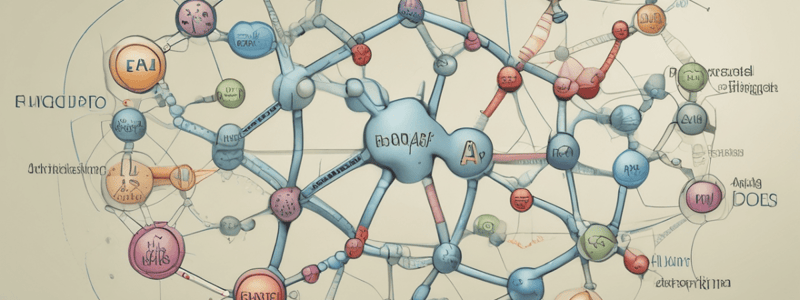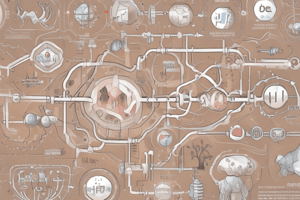Podcast
Questions and Answers
What is a source of amino acids for catabolism?
What is a source of amino acids for catabolism?
- Excess sugars from diet
- Fat stored in adipose tissue
- DNA from dead cells
- Leftover amino acids from normal protein turnover (correct)
All amino acids can undergo gluconeogenesis.
All amino acids can undergo gluconeogenesis.
False (B)
What is the purpose of the ubiquitin tagging system in protein degradation?
What is the purpose of the ubiquitin tagging system in protein degradation?
To recognize and tag proteins that need to be degraded.
Proteins are continuously synthesized and degraded, with half-lives ranging from ___________ to weeks.
Proteins are continuously synthesized and degraded, with half-lives ranging from ___________ to weeks.
What is the primary function of proteasome in protein degradation?
What is the primary function of proteasome in protein degradation?
Match the following protein types with their characteristic half-lives:
Match the following protein types with their characteristic half-lives:
Lysosomal hydrolysis degrades all proteins in the body.
Lysosomal hydrolysis degrades all proteins in the body.
What is the significance of protein turnover in tissues undergoing structural rearrangement?
What is the significance of protein turnover in tissues undergoing structural rearrangement?
What is the fate of the nitrogen atom after deamination of an amino acid?
What is the fate of the nitrogen atom after deamination of an amino acid?
Amino acid degradation occurs mainly in the kidneys.
Amino acid degradation occurs mainly in the kidneys.
What is the purpose of deamination in amino acid catabolism?
What is the purpose of deamination in amino acid catabolism?
The α-keto acids resulting from deamination are further metabolized to enter the _____ mainstream.
The α-keto acids resulting from deamination are further metabolized to enter the _____ mainstream.
How do different animals excrete excess nitrogen?
How do different animals excrete excess nitrogen?
Match the following compounds with their role in nitrogen excretion:
Match the following compounds with their role in nitrogen excretion:
What is the role of N-acetyl-glutamate in the urea cycle?
What is the role of N-acetyl-glutamate in the urea cycle?
Amino acids are classified as either glucogenic or ketogenic, but not both.
Amino acids are classified as either glucogenic or ketogenic, but not both.
What is the difference between glucogenic and ketogenic amino acids?
What is the difference between glucogenic and ketogenic amino acids?
Carbamoyl phosphate synthetase I is the main enzyme that ______________ the urea cycle.
Carbamoyl phosphate synthetase I is the main enzyme that ______________ the urea cycle.
Match the following amino acids with their classification as glucogenic, ketogenic, or both:
Match the following amino acids with their classification as glucogenic, ketogenic, or both:
What is the result of the catabolism of ketogenic amino acids?
What is the result of the catabolism of ketogenic amino acids?
Essential amino acids can be synthesized by the human body.
Essential amino acids can be synthesized by the human body.
What is the role of arginine in the urea cycle?
What is the role of arginine in the urea cycle?
Amino acids are classified as glucogenic, ketogenic, or ______________ based on the intermediates produced during their catabolism.
Amino acids are classified as glucogenic, ketogenic, or ______________ based on the intermediates produced during their catabolism.
What is the result of the catabolism of glucogenic amino acids?
What is the result of the catabolism of glucogenic amino acids?
Flashcards are hidden until you start studying
Study Notes
Amino Acid Catabolism in Mammals
- Sources of amino acids for catabolism: leftover amino acids from normal protein turnover, dietary amino acids that exceed body's protein synthesis needs, and proteins broken down to supply amino acids for energy when sugars are scarce (starvation, malnutrition, diabetes mellitus).
- Not all amino acids can undergo gluconeogenesis, and only ketogenic ones can do so.
Protein Turnover
- Proteins are continuously synthesized and degraded (turnover), including digestive enzymes and plasma proteins.
- High rates of protein degradation occur in tissues undergoing structural rearrangement, such as uterine tissue during pregnancy.
- Structural proteins, such as collagen, are metabolically stable and have half-lives measured in months or years.
- Lysosomal hydrolysis degrades some proteins.
Protein Degradation
- Some proteins are targeted for degradation by a covalent attachment of ubiquitin (Ub) at the C-terminus.
- Proteasome hydrolyzes ubiquitinated proteins.
- Ubiquitin tagging system recognizes proteins that need to be degraded.
Deamination
- The α-amino group must be removed from amino acids, as there are no nitrogenous compounds in energy transduction pathways.
- Deamination is an obligatory step in catabolism of all amino acids.
- Once removed, nitrogen can be incorporated into other compounds or excreted.
Urea Cycle
- The major site of amino acid degradation in mammals is the liver.
- Carbamoyl phosphate synthetase I is the main enzyme that starts the urea cycle.
- This enzyme is activated by N-acetyl-glutamate, which is formed when glutamate and acetyl-CoA concentrations are high.
Amino Acid Classification
- Amino acids are classified as glucogenic, ketogenic, or both based on the intermediates produced during their catabolism.
- Glucogenic amino acids yield pyruvate or citric acid cycle intermediates, while ketogenic amino acids yield acetoacetate or acetyl-CoA.
Amino Acid Degradation
- Different amino acids have different degradation pathways.
- Some amino acids, such as phenylalanine, tyrosine, and tryptophan, are both glucogenic and ketogenic.
Studying That Suits You
Use AI to generate personalized quizzes and flashcards to suit your learning preferences.



